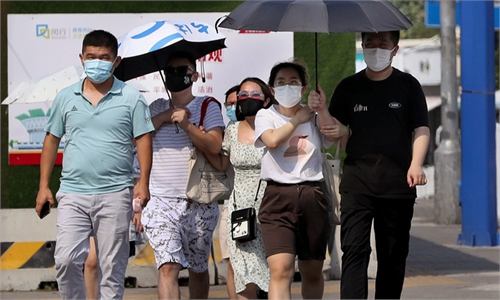
Giant panda Shuaishuai eats beside an ice cube at Chimelong Safari Park in Guangzhou, south China's Guangdong Province, July 22, 2022. The zoo tries every means to help animals fend off the summer heat in recent days. Photo:Xinhua
Since the start of summer, residents from across China have found themselves experiencing a summer so hot that it could be recorded in the history books. According to the latest monitoring assessment by the National Meteorological Center (NMC), the national average temperature in July was the second-highest on record since 1961.
In July, the national average of high temperature days (daily maximum temperature ≥ 35 C) was 5.6 days, two days more than the average for the same period of the year, and the second most since 1961, said officials from the China Meteorological Administration at a news conference on Wednesday night. The national average precipitation in July was 96.6 millimeters, the second-lowest on record for the same period.
However, although the frequency of hot weather has been quite notable this year, it has not reached abnormal levels, climate experts said.
At 6 am on Thursday, the NMC issued yet another high temperature warning involving most parts of China. Northwest China's Shaanxi, North China's Hebei, Beijing and Tianjin, East China's Shandong and Shanghai, Central China's Hubei and Hunan, Southwest China's Sichuan and Chongqing, and South China's Guangxi are all expected to be hit by high temperatures of 35 C or higher, the NMC said. Temperatures in some of these areas could surpass 37 C or even 40 C.
At 12 pm on Thursday, the Shanghai Central Meteorological Station elevated its yellow warning for high temperatures to an orange warning, the second-highest level of extreme weather warnings in China. High temperatures in Shanghai's city center and some suburbs will exceed 37 C, the station said.
In the meantime, the weather in Beijing has reached a level that is almost unbelievable. At 6 pm on Thursday, a rainstorm warning was issued in Beijing on top of the heat and wind warnings that were issued earlier.
According to a widely used weather app, Beijing's apparent temperature reached 46 C at one point on Thursday, and the humidity reached 68 percent.
As felt by many, the heat wave being experienced in northern China is characterized by a combination of high temperatures and high humidity, weather experts told the Global Times on Thursday. Southern China, on the other hand, is experiencing less rainfall than in previous years and is even facing droughts in some areas.
Atmospheric physicist Wang Gengchen, a research fellow at the Institute of Atmospheric Physics of the Chinese Academy of Sciences, described the recent weather as "steaming and boiling."
Most of China has been experiencing rare hot weather recently, Wang told the Global Times, explaining that the main reason is the northward shift of subtropical high pressure and the combination with the humid air that has been prevalent this season.
"As a result of this combination, the affected areas are either swelteringly hot and sunny or stormy," he said, noting that both types of weather make people uncomfortable.
Wang said that judging by the current conditions, although the recent high temperatures are relatively rare, they have not yet reached abnormal levels.
However, the high temperatures are just part of a series of catastrophic weather events. South China is also facing challenges from typhoons and floods, while parts of East and Central China are suffering from droughts.
Guangdong officials held a working meeting on Wednesday night on the province's defense against a tropical depression in the South China Sea and potential flooding. Provincial-level regions such as Inner Mongolia, Xinjiang and Jiangxi Province have increased their arrangements to deal with droughts.
To address the challenges of hot weather, China's State Grid is placing more emphasis on electricity supply. Various provincial-level regions such as Tianjin, Chongqing and Jiangxi have taken measures to ensure the supply of electricity to residents during the sweeping heat, according to China Electric Power News.
Experts pointed out that secondary disasters from the combination of the high temperatures and other extreme weather require additional attention.
Hospitals in several parts of China reported several cases of heat-related illnesses in July. The situation has not previously received enough attention from the Chinese public, Wang noted.
"Most of the Chinese population has always thought that heat stroke is just a minor thing that doesn't lead to serious consequences," Wang said. "And this year's extreme heat has in fact led to deaths caused by heat stroke. The Chinese public should be alert to this."
In July, the unprecedented heat wave also scorched other parts of the Northern Hemisphere, including Europe and the US. The UK recorded its hottest-ever day on July 18, with temperatures hitting a high of 40.3 C in the east of England, as London's fire service tackled several blazes across the capital.
The US is also seeing extreme heat. In the cities of Dallas, Oklahoma and Houston, temperatures reached 37.8 C. In the Mid-Atlantic and Northeast regions, the apparent temperature reached 36°C to 42°C.
One piece of good news is that August shouldn't see another heat wave like July, Wang said.
"Nighttime temperatures will be significantly cooler, which will affect daytime temperatures as well," he said. "There's nothing in sight that will cause August to continue to be unusually hot."




